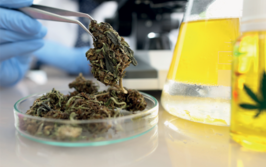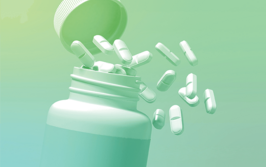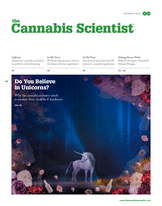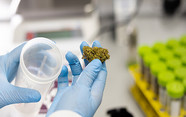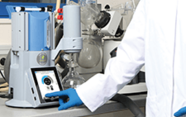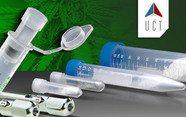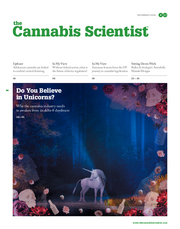Cannabis Science: 2022 Retrospective
Looking back on 12 months of cannabis news, we compiled the best cannabis research stories over the past year
Margot Lespade | | 12 min read | News

January
Cannabinoids and COVID-19. A research team, led by Richard van Breemen, uncovered the role of cannabinoid acids in blocking cellular entry of SARS-CoV-2. Their approach, based on affinity selection-mass spectrometry, identified three cannabinoids – CBD-A, CBG-A and THC-A – as being potential allosteric inhibitors of the viral spike protein. To test whether CBDA and CBGA prevented infection, the live virus was incubated with 25 μg/mL of either substance and then used to infect Vero cells. After 24 hours, they found an absence of SARS-CoV-2 viral RNA in the cells. Importantly, they found that CBDA and CBGA blocked both infection of the original live virus, as well as variants of concern, including the B.1.1.7 and B.1.351 strains.
Meanwhile, researchers looked into whether individuals suffering with chronic pain were able to effectively reduce their opiate use with medical cannabis. They conducted a retrospective cohort study looking to see whether the individuals exhibited lower morphine milligram equivalent (MME) levels following medical cannabis certification. Their results showed a reduction of -12.3 MME across all individuals and as much as 31.3 percent in those with baseline opioid use.
A first-of-its-kind clinical trial studying the effect of synthetic cannabinoid, Nabilone, on treatment of obesity received Toronto Cannabis and Cannabinoid Research Consortium funding.
February
The basis of bong lung. For years, doctors have been aware that some people who smoke a lot of cannabis present with a severe form of emphysema colloquially known as “bong lung.” However, it has historically been challenging to study the effects of smoking cannabis due in part to its illegal status in many parts of the world. Now, research from the University of Otago has found that – contrary to previous assumptions – smoking cannabis leads to a different pattern of lung function changes compared with smoking tobacco. Importantly, cannabis appears to lead to over-inflated lungs and increased resistance to airflow. The results form part of the Dunedin Multidisciplinary Health and Development Study, arguably the world’s most complete dataset on lifetime cannabis use and lung function in adults.
Researchers also explored the effects of cannabis on ADHD symptoms, ADHD medication side effects, and ADHD-related executive dysfunction. Notably, 12 percent of participants had an ADHD diagnosis, while the rest reported ADHD-related symptoms. Participants reported positive effects of cannabis on hyperactivity and impulsivity, and positive impacts on ADHD medication side-effects, such as difficulty sleeping and loss of appetite.
The NFL granted one million dollars in research funding to study effects of cannabinoids on pain management and neuroprotection from concussion in elite football players.
March
Hit and run. According to a pilot study, CBD appeared to alter some key physiological and psychological responses to aerobic exercise without impairing performance. Researchers investigated the effects of an acute, oral 300 mg CBD treatment versus a placebo on male endurance-trained runners during a running task. Results suggested that CBD affects several key variables, including submaximal and maximal oxygen consumption, markers of exercise-induced inflammation and feelings of pleasure during submaximal exercise. In the absence of any clear detrimental effects, researchers suggested CBD may be useful in a sporting context, and called for further studies involving more participants and different dosing regimens to better understand what’s going on.
With industrial hemp generating increasing interest and its chemical composition varying greatly depending on multiple factors, there is significant benefit to being able to differentiate between strains. As such, researchers designed a new two-dimensional liquid chromatography (LC×LC) method paired with a demodulation process for the differentiation of two varieties of industrial hemp based on their cannabinoid and phenolic compounds. Two industrial hemp strains (cookie and gelato) were analyzed using the new technique, with the cookie strain showing a total of 41 cannabinoid markers, while the gelato strain presented more representative phenolic compounds.
April
To bee or not to bee. Honey population decline led researchers from the University of Life Sciences in Lublin, Poland, to explore the effect of hemp extract on the activity of the antioxidant system in honey bees. They split the bees into three groups; bees in the control group were fed only sugar syrup, while the two experimental groups received hemp extract via different administration methods. One was fed pure sugar syrup via cotton strips soaked in hemp extract placed inside the cage, and the second group was fed a mixture of sugar syrup and hemp extract via a syringe. The syringe method demonstrated a stronger and faster effect compared with the strip method. The authors hypothesized that this was because it took longer for the extract from the strip to enter the bees’ system, rather than directly through the syrup in the syringe. Overall, hemp extract increased the activity of antioxidant enzymes, and extended the life of bees from 35 days for the control group to 49 days (for the strip method) and 56 days (for the syringe method). The authors highlighted that hemp extract may contribute to the improvement of natural immunity in honey bees and help them fight against environmental pollution and increased oxidative stress.
Elsewhere, researchers found that CBD, when paired with polymyxin B (PB), showed antibacterial efficacy against multidrug-resistant gram-negative-bacilli.
May
Police prejudice and marijuana misuse. In a first-of-its kind study, researchers examined the association between cannabis use and both direct (as a victim or witnessing in person) and indirect (seen in media) exposure to racism-based police use-of-force among Black emerging adults. Though the authors did not appear to draw any conclusions about the link between cannabis use and direct exposure in men, they did conclude that male participants having experienced indirect exposure to racism-based police violence reported more cannabis use. For female participants, no link was found. The authors noted that it is difficult to make directional inferences from these results, as participants who report more cannabis use may also come into contact with police more frequently.
Can we trust cannabis labeling? Researchers set out to analyze the cannabinoid and terpene diversity of almost 90,000 samples from six US states and compared what they found with labels. Although they found distinct cannabis chemotypes were reliable across all regions, the commercial labels on cannabis products did not consistently align with the observed chemical diversity. Specifically, Indica/Hybrid/Sativa nomenclature does not appear to be a reliable indicator of true chemical content – but “strain” names seem to be slightly more reliable overall. That said, some “strains” were less reliable than others, suggesting these are also not an ideal marker of chemical content.
Global legal cannabis market was predicted to hit US$48.3 billion by 2028, with 24.8 percent compound annual growth rate.
June
Accidental doping. According to the World Anti-Doping Agency, all cannabinoids (apart from CBD) are prohibited in competition; however, with the use of hemp products on the rise, a team of researchers decided to investigate whether hemp products could lead to unintentional violations of anti-doping regulations. Using gas chromatography-tandem mass spectrometry, 23 commercially available hemp products were analyzed. A single-dose administration study examining the presence of 16 cannabinoids in urine collected pre- and post-consumption revealed that 33 percent of samples contained a prohibited cannabinoid that would have resulted in an unintentional violation of anti-doping regulations. The authors noted that athletes need thorough education about the risk of consuming hemp products.
The war in Ukraine accelerated medical cannabis legalization efforts, with the aim of allowing patients access to “necessary treatment of cancer and post-traumatic stress disorder resulting from war.”
July
Cannabinoids for Alzheimer’s? The prevalence of Alzheimer’s disease (AD) – and the limited treatment options – inspired a team of researchers to examine the potential beneficial effects of cannabinoid microdoses to improve memory and brain functions of a patient with mild AD (main symptoms of memory deficit, spatial and temporal disorientation, and limited daily activity). Specifically, the patient was given microdoses of cannabis extract over a period of 22 months, and then assessed with the Mini-Mental State Examination and Alzheimer’s Disease Assessment Scale-Cognitive Subscale. The outcome? Apparently, both the patient and caregiver reported an improved quality of life, with reduced mood swings and improved memory and cognition. Good news, but the authors (unsurprisingly) stressed that placebo-controlled clinical trials are needed to confirm the findings.
A group of researchers from the Federal University of Minas Gerais, Brazil, analyzed 176 websites after Googling the term “medical cannabis.” Fifty two percent were news websites with pain, multiple sclerosis, and epilepsy being the most frequently mentioned therapeutic areas. Information was often incomplete – only 22 percent of the webpages reported potential side-effects. Overall, results demonstrated that online information is not always aligned with science-based evidence and could raise unrealistic expectations, potentially leading to patients self-medicating using cannabis-based products.
The US federal government handbook got a new section on cannabis potency, measurement, and labeling.
August
A promising clinical trial? Glioblastoma is an aggressive and fast-growing brain cancer with a very low five-year survival rate of five percent. Currently, the very few treatment options that exist are not always effective, as the tumor can begin regrowing after a few months of treatment. As such, a UK clinical trial called ARISTOCRAT is investigating whether combining cannabinoids with traditional chemotherapies can improve glioblastoma patient outcomes. With promising results in phase I, this phase II, double-blind randomized trial will combine Sativex with the usual treatments of radiotherapy and chemotherapy with temozolomide (TMZ). The trial is recruiting patients with recurrent glioblastoma to find out whether the addition of Sativex to standard TMZ treatment improves how long patients live, delays the growth of their tumor, and/or improves their quality of life.
Average secondhand PM2.5 concentrations from smoking cannabis indoors found to be 4.4 greater than PM2.5 concentrations from smoking tobacco cigarettes indoors.
Brittney Griner’s lawyers filed an appeal against her nine-year prison sentence for cannabis possession.
September
Mouse marijuana. The loss of ovarian 17β-estradiol (E2) can be linked with gut dysbiosis, inflammation, and increased risk of cardiometabolic disease and osteoporosis in postmenopausal women. Wanting to explore alternative options to hormone replacement therapy, a group of researchers explored the effect of CBD in estrogen-deficient mice. Compared with controls, the CBD-treated mice showed improved bone density, suffered less inflammation in gut and bone tissues, and possessed higher levels of beneficial gut bacteria, as well as improved glucose tolerance and more energy. In a related press release, Diana Roopchand, one of the study authors said, “CBD is already being used by many women to deal with symptoms of menopause and postmenopause. This study provides preclinical evidence to support further investigation of CBD as a therapeutic for post menopause-related disorders.”
Twenty-eight year study reveals decline in US adolescent substance use with the exception of cannabis and vaping – reasons may be linked to parental monitoring, social engagement, and employment.
New method using gas chromatography-mass spectrometry separates trichomes from plant material – allowing cannabinoid analysis of low abundance not observed in raw plant extract.
October
Speedy dilute-and-shoot. Researchers from the University of Rochester Medical Center, NY, United States, reported a liquid chromatography-tandem mass spectrometry assay that quantifies cannabis metabolites THC-COOH and THC-COO in human urine. The assay uses a direct dilute-and-shoot approach that simplifies the sample preparation process, and improves overall throughput for a quick and accurate cannabis use detection method. The turnaround time was five minutes – a significant improvement over existing dilute-and-shoot assays that typically take 20 minutes. Researchers believe this new method can be easily applied and routinely performed in any clinical laboratory setting.
Although the US is at the center of the opioid crisis, the issue is an increasing public health concern in other countries – including the UK, Sweden, and Australia. As such, researchers from Florida, US, decided to investigate the effects of medical cannabis on opioid use. The resulting study revealed that medical cannabis patients are reporting decreased opioid use and overall improvements in health functioning after legalization – potentially confirming cannabis’ harm reduction role.
Canadian government set to review cannabis legalization – four years after it became world’s second to legalize cannabis for adults.
Biden announced steps to change federal cannabis laws and pardoned all prior offenses of simple possession.
November
Don’t smoke before surgery. The use of cannabis may have a negative effect on the postoperative outcome of a simple, minimally invasive bypass surgery. Researchers at Michigan Medicine, US, collected data from the Blue Cross Blue Shield of Michigan Cardiovascular Consortium to examine patients undergoing vascular surgical procedures – assessing their 30-day and one-year outcomes. Out of the 11,013 patients identified, nine percent reported cannabis use in the month prior to lower extremity bypass. Compared with non-cannabis users, patients using cannabis had decreased patency, were more likely to use opioids after discharge, and more likely to need amputation one year after surgery.
Biden’s pardons for thousands of Americans convicted of cannabis possession left many behind and did not apply to state charges or immigrants at risk of deportation.
December
Over the limit. Industrial hemp is becoming a popular choice for livestock feedstuffs, but what effect does it have on the food chain – and could we be getting more than we bargained for in our dairy products? Researchers from Germany conducted a feeding experiment, where one group of dairy cows were fed cannabinoid-rich industrial hemp silage, while the other group were fed a low cannabinoid variety. Their milk, blood plasma, and feces were collected and analyzed using LC-MS/MS to quantify cannabinoid concentration. Cows fed with high levels of THC produced less milk and exhibited a negative change in heart rate, respiratory rate, and behavior. The team detected concentrations of up to 316 µg THC per kg of milk in these same animals – levels that could potentially exceed the acute reference dose in some population groups in several milk consumption scenarios.
A US study revealed a 245 percent increase in adolescent cannabis abuse since 2000, while alcohol abuse has steadily declined over the same period. According to the researchers, edible cannabis showed the highest average monthly increase compared to alternative ingestion modes – suggesting that adolescents have moved away from cannabis smoking. The results highlight an ongoing concern about the impact of rapidly evolving cannabis legalization on adolescents and young adults.
According to a new report, nearly 2 million US cannabis convictions have been pardoned or expunged in the past five years.
Margot Lespade, Associate Editor, The Cannabis Scientist
